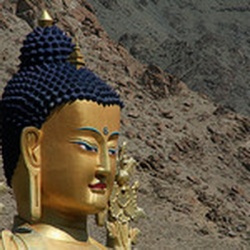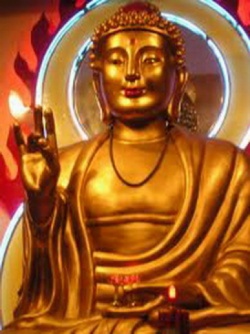In Search of the Missing Stupa!
Recently Muhammad Yusuf Taing, the former head of the State’s Cultural Academy, claimed that he knows the place where the most sought after copper plaques engraved with the scriptures of the 4th Buddhist Council are buried. He was ready to disclose the location provided the President of India gives an undertaking that these copper plaques will not be taken out of Kashmir like some other historical artifacts discovered earlier. The 4th Buddhist Council held in Kashmir in 100 A.D. during the time of Kushan King Kanishka is supposed to be a turning point in the spread of Buddhism throughout Asia.
The Council was held somewhere near Harwan in Srinagar and 500 Bhikkus led by Vasumitra participated in the deliberations. Kashmir has been one of the most important centres for the spread and development of Buddhism. Buddhism was an important part of the classical Kashmiri culture, as is reflected in the Nilamata Purana and the Kalhana's Rajatarangini. Buddhism is generally believed to have become dominant in Kashmir in the time of Emperor Ashoka, although it was prevalent there long before his time. It enjoyed patronage not only of the Buddhist rulers, but Hindu and early Muslim rulers too. From Kashmir it had travelled to the neighbouring Ladakh. The Kushana period saw a great resurgence of Buddhism in Kashmir, especially during the reign of Kanishka. The fourth Buddhist Council as already mentioned, was held in Kashmir, under the presidency of Katyayaniputra, in Kanishka's time. The south Indian Buddhist philosopher Nagarjuna lived in Kashmir during the Kushana period. It is said that during the council, there were all together three hundred thousand verses and over nine million statements compiled, and that it took twelve years to complete. This council did not rely on the original pali canon (the Tipitaka). Instead, a set of new scriptures were approved, as well as fundamental principles of Mahayana doctrine.
The new scriptures, usually in the Gandhari vernacular and the Kharosthi script, were rewritten in the classical language of Sanskrit, to many scholars a turning point in the propagation of Buddhist thought. The new form of Buddhism was characterized by an almost God-like treatment of the Buddha, by the idea that all beings have a Buddha-nature and should aspire to Buddhahood, and by a syncretism due to the various cultural influences within north-western India and the Kushan Empire, especially from Zoroastrianism and Greco-Buddhism. The earlier Hinayan School was supposed to be very strict and involved total abnegation but the new school, Mahayana, was more moderate and practical. From that point on, and in the space of a few centuries, Mahayana was to flourish and spread into Central Asia, China, Korea, and Japan (introduction of Buddhism in 538 AD). Thus the Fourth Buddhist Council had been an event of far reaching consequences. The scriptures of this Council which changed the face of Buddhism are the most valuable documents. The search for these copper plaques has been going on for a very long time but no one has been able to locate the place where these were buried for posterity.
I have also been participating in a search for these invaluable heritage assets of Kashmir with Prof.Dr. Fida Mohammad Hassnain. During his tenure as the Director of Archaeology and Museums in Kashmir, he used to take me on his various forays for the search of the missing stupa. We went all over the valley in this behalf. Yechgam in Budgam area. A number of spots in Shopian. Varmul, Sopore, Lolab, Bandipore,Tral and many other spots but we did not succeed in getting the location. In fact, there is a mound of an ancient Buddhist stupa in Varmul.
According to Fida Saheb, during the tenure of late G M Sadiq, the son of Kashmir’s famous poet Mahjoor had also claimed that he knew the location of the missing stupa, the place where the copper plaques of the Fourth Buddhist Council were buried. He too had laid a number of conditions for disclosing the location. However, nothing came of it and the site remained as elusive as ever. Now that the subject is again in limelight, it would be a fantastic thing for Kashmir if the copper plaques are unearthed and preserved for posterity in a Museum. Normally for all such discoveries of International importance it is the ideal thing to have their exhibition and storage at the place of discovery itself. I would strongly like to endorse the plea of Muhammad Yusuf Taing for a written undertaking from the President of India that the copper plaques after excavation will not be taken out of Kashmir.
I too like Taing Saheb have a bitter experience of something similar happening with the site connected with the origin of Kashmiris. There is only one definite and irrefutable scientific evidence about the beginning of human civilisation in Kashmir and that is the Neolithic (New Stone Age) dwelling sites in many parts of the valley out of which Burzahom site is the most studied and well known in the scientific community. But the significance of the site is not so much known among the people at large. Burzahom Neolithic Site is on a Karewa in the neighbourhood of Shalimar-Telbal road. It has a beautiful location. On one side in the distance is the Dal lake while in the backdrop is Mahadev peak. The site is famous because it was the first such site discovered in Kashmir. It has dwelling pits, burial pits and some megaliths. The Neolithic (or the New Stone Age) Period of this site dates back to around 3,000 BC. In a way the place represents the site as well as the period where from the first inhabitants of our beautiful valley came.
They could be termed the original Kashmiris who started inhabiting this valley like their counter parts in many other areas of the world. I visited the site first in 1969 when it had been freshly excavated. The then Chief Minister late G.M.Sadiq in an informal discussion about the history of Kashmir had informed me about the existence and discovery of this and other sites. He had been taking personal interest in its excavation and was desirous of having a museum on the site itself to house the various implements discovered there. In an informal chat he mentioned to me that he was very much apprehensive that everything discovered here would be taken to the National Museum in Delhi and we would be left with pits only! Because of this fear he had sanctioned construction of a Museum on the site itself. On visiting the site again a few years after his death his words proved prophetic. There was nothing at the site except some pits full of rain water and half complete concrete pillars erected to provide a roof over these. Everything had been taken to Kolkatta! It may be mentioned that the excavation of these scriptures in original form and housing these at the site in a museum would be a tremendous draw for not only Buddhists from all over the world but for scholars, historians, and researchers. It would be ideal if the Civil Society itself sets up a watchdog group of historians, scholars, legal luminaries, media personnel, and intellectuals led by Taing sahib to oversee the excavation and preservation of these copper plaques. That may be the only way to safeguard our ever diminishing and vanishing heritage!

